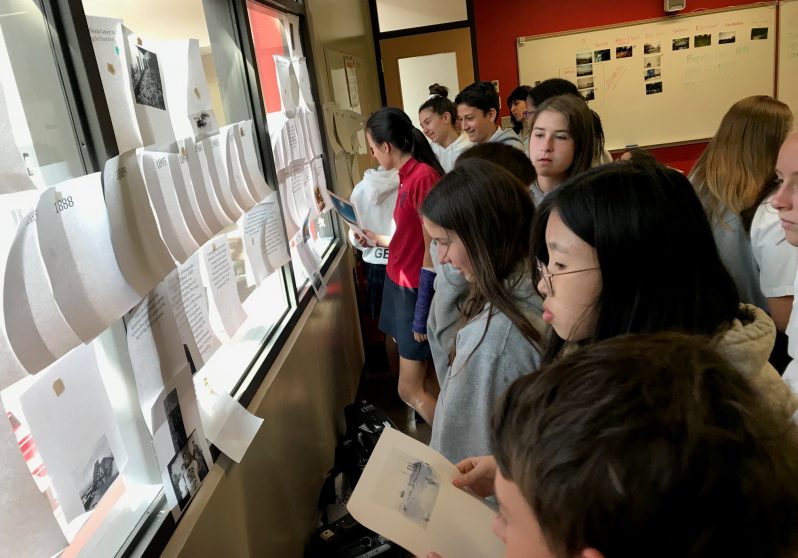Holy Trinity: Changing Landscapes
Thursday November 7th, 2019

Overview:
This was a school-wide inquiry into the relationships between STEAM experts, story-telling, and changing landscapes.
Connection to the Vancouver Biennale Exhibition:
We visited numerous Vancouver Biennale art forms throughout the inquiry. We also virtually visited artworks. To launch the project and “tune into” relationships between art, community, storytelling, and changing landscapes, we inquired into the connections between Amazing Laughter, by Yue Minjun, and Vancouver as a “Most Liveable City” through the question: How does art change the landscape in ways that help us to connect to the past and reimagine our city? We also explored the Acoustic Anvil, by Maskull Lasserre, to make connections between the history of that area, how/why it has changed over time, and how artists tell the story of that change. Students explored the relationships between Acoustic Anvil and public art installations in the Shipyards in Lower Lonsdale, a local neighbourhood for our students.
Enduring Understanding:
Artists tell a story of changing landscapes to honour past communities and shape future cities.
Guiding Questions:
- How does the landscape tell a story of past, present and future communities?
- How does technology help to capture and transform landscapes?
Cross-Curricular Access:
Access in Social Studies/Mathematics:
Students explored relationships between changing landscapes and displacement of local peoples over time, with an emphasis on Truth and Reconciliation. We also looked at migration and immigration patterns and how movement of peoples, for a variety of reasons, changes landscapes and the concept of “home”. With increased gentrification in the Lonsdale area, we explored the concept of renoviction and how local governments are thinking about this challenge in relation to the question of Vancouver’s livability/standard of living for Vancouverites. Is Vancouver the most liveable city for all?
Access in ADST
This STEAM inquiry involved exploring connections between architecture, technology and high density living. Community walks, engineering inspired challenges, close looking at site plans, and tech take-apart activities provided students with opportunities to explore relationships between our changing landscape from multiple perspectives, culminating in the ability to share their own story within a changing community.
Inquiry Challenges:
- Artist’s session launch: How does our partner artist tell the story of changing landscapes and why? What inspires this artist? How/why do they use their craft to engage the community? What is the artist’s intent? What do they hope for? What is our responsibility, if any, as viewers?
- Trip to Amazing Laughter, Acoustic Anvil and more! Cross curricular field study: How does art change the landscape in ways that help us to connect to the past and reimagine our city? Students took up our guiding questions as we explored the Vancouver Biennale installations alongside the Vancouver Biennale’s mission.
- Photography and Assemblage: Students explored construction sites and plans in their local neighbourhood where rapid community change is occurring, in-role, through a STEAM lens (e.g, look at this site from the lens of being an engineer). Using found objects, construction materials (blocks, lego, etc.) and photography, children create renderings of their “noticings.” Using materials and the thinking routine “Creative Questions,” children explored their beginning STEAM inquiries.
- Collaboration with Squamish nation: We invited Rosemary Georgeson to work with us ongoing to support authentic First Nations perspective, and connections between storytelling and changing landscapes in North Vancouver. She worked with four classes to create collective poems about their relationship with places the classes selected, and she shared stories of her connections to the lands and waters.
- Students-as-artists: Students explored the significance of Home or other significant place through loose parts in the studio. What patterns emerge as we tell our significant place stories? What mediums did we choose and why? What is our artist intent? In what ways, if any, is this intent realized by others? Is that realization important to us as the artist?
- Visit to the North Vancouver archives and artifact kit exploration: Students explored time-lapse videos, still photography, maps and belongings to gather further clues into the stories of changing landscapes in North Vancouver. Children began to look for patterns in their findings and asked further questions to explore their inquiries alongside our artist partners and community experts, more deeply.
Student Creation/Taking Action:
We co-created a Learning Museum with students and experts. The school transformed into a collection of interactive exhibits and hands-on activities designed by students to provoke thinking about significant learning within the inquiry. This included:
- (Re)creating new technologies out of “old” technologies (e.g., reimaging a slide from an old slide projector to project).
- Entryways decorated with found materials (inspired by the question: How do you carry the land? from Ayumi Goto and Peter Morin’s recent Vancouver Art Gallery exhibit )
- Student photography panels with quotes and provocations
- Time-lapse videos